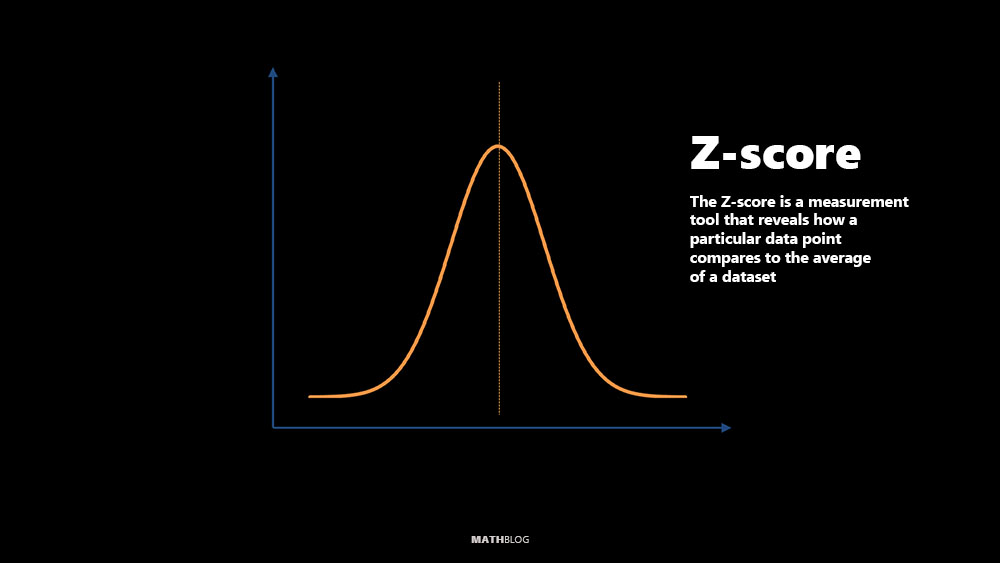The Z-score is a measurement tool that reveals how a particular data point compares to the average of a dataset. This tells us how many standard deviations away a data point is from the mean, offering a clearer picture of its position within a broader dataset. Whether you’re examining test scores, financial data, or scientific measurements, Z-scores help in making sense of raw data by placing it in a relative context.

Important things to know about a Z-scores:
- Positive Z-score: A positive Z-score indeed indicates that the data point is above the mean (average) of the dataset. The higher the Z-score, the further the data point is above the average.
- Negative Z-score: Conversely, a negative Z-score signifies that the data point is below the mean of the dataset. A more negative Z-score means the data point is further below the average.
- Z-score Close to 0: A Z-score close to 0 suggests that the data point is very close to the mean of the dataset, indicating average or typical performance or measurement within the context of the data.
- Unusual Data Points (Z-score > 3 or < -3): In many datasets, especially those that follow a normal distribution, a Z-score greater than +3 or less than -3 is considered unusual or an outlier. This is because, in a normal distribution, about 99.7% of values lie within three standard deviations (positive or negative) from the mean. Therefore, data points with Z-scores beyond these thresholds are statistically rare and can be considered outliers.
The Basic Z-Score Formula
The formula for calculating a basic Z-score in a single sample is straightforward:
In this formula, \( x \) represents the data point, \( \mu \) is the mean of the dataset, and \( \sigma \) is the standard deviation.
Example
To demonstrate how Z-scores can be applied we can understand the significance of deviations in data in a practical context. Consider a city where the average monthly temperature for July is 78°F, with a standard deviation of 5°F. Suppose you want to find out how unusual this year’s July temperature of 85°F is compared to the typical July temperatures in that city.
Given values:
- the \( x \)-value is the temperature we are examining, which is 85°F.
- the average July temperature for the city is 78°F, so \( \mu \) = 78°F.
- the standard deviation of July temperatures is 5°F, so \( \sigma \) = 5°F.
We can now apply the Z-score formula.
A Z-score of 1.4 means that this year’s July temperature is 1.4 standard deviations above the average. This indicates that the temperature was significantly higher than what is typical for July in that city. Using the Z-score table, we see that a Z-score of 1.4 corresponds to 0.9192. This implies that only about 8.1% (100% – 91.92%) of the time would you expect to see a July temperature as high as or higher than 85°F in this city.
Z-score with Standard Error of the Mean (SEM)
When dealing with multiple samples, the Z-score formula adjusts to account for the standard error. The new formula is used to determine how many standard errors a sample mean is from the population mean. A higher Z-score indicates that the sample mean is further away from the population mean.
The Z-score formula taking the Standard Error of the Mean into consideration is:
Below is a table summarizing the implications of high, low, and near-zero Z-scores:
| Z-score | Description | Implications |
|---|---|---|
| High Z-score | A Z-score significantly greater than 0, indicating that the sample mean is much higher than the population mean. | Suggests that the observed difference is unlikely due to random chance alone. Indicates strong evidence of a real difference from the population norm. |
| Low Z-score | A Z-score significantly less than 0, showing that the sample mean is much lower than the population mean. | Implies that the sample mean is close to the population mean, indicating consistency with the population trend. May also suggest that differences could be masked by small sample size or high variability. |
| Near-zero Z-core | A Z-score close to 0, meaning the sample mean is very close to the population mean. | Indicates that any observed difference between the sample and the population is likely not statistically significant and could be due to random sampling variability. |
Understanding the Standard Error of the Mean (SEM)
The Standard Error of the Mean (SEM) is calculated as \( \frac {\sigma}{ \sqrt n} \). It represents the standard deviation of the sampling distribution of the sample mean. In simpler terms, it estimates how much the sample mean is expected to vary from one sample to another. The SEM decreases as the sample size increases, indicating more precise estimates of the population mean.
Example
Suppose you are analyzing the average monthly expenditure of households in a city. The known average expenditure (population mean) is $2,000 with a population standard deviation of $300. You take a sample of 50 households and find the average expenditure is $2,100.
The Z-score can be calculated as follows:
This Z Score of approximately 2.36 indicates that the sample mean is about 2.36 standard errors away from the population mean.
For easier computation, use our Z-score calculator.